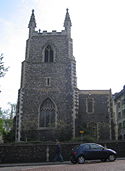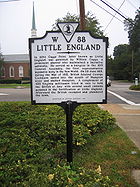
William Capps
Encyclopedia

Norwich
Norwich is a city in England. It is the regional administrative centre and county town of Norfolk. During the 11th century, Norwich was the largest city in England after London, and one of the most important places in the kingdom...
, Norfolk County, England, 11-Dec-1596, at St. Michael at Plea. He and his wife had five children together: Henry, Frances, Willoughby, Anne, and William.
Arrival Virginia

Sea Venture
The Sea Venture was a 17th-century English sailing ship, the wrecking of which in Bermuda is widely thought to have been the inspiration for Shakespeare's The Tempest...
and was apparently among those shipwrecked in Bermuda
Bermuda
Bermuda is a British overseas territory in the North Atlantic Ocean. Located off the east coast of the United States, its nearest landmass is Cape Hatteras, North Carolina, about to the west-northwest. It is about south of Halifax, Nova Scotia, Canada, and northeast of Miami, Florida...
for several months before reaching the New World. William Capps arrived in Virginia in 1609-1610 and settled at Kecoughtan
Kecoughtan, Virginia
Kecoughtan in Virginia was originally named Kikotan , the name of the Algonquian Native Americans living there when the English colonists arrived in the Hampton Roads area in 1607....
on the west side of the Hampton River
Hampton River
The Hampton River is a tidal estuary which empties into Hampton Roads near its mouth. Hampton Roads in turn empties into the southern end of Chesapeake Bay in southeast Virginia in the United States...
. This site is in present-day Hampton, Virginia
Hampton, Virginia
Hampton is an independent city that is not part of any county in Southeast Virginia. Its population is 137,436. As one of the seven major cities that compose the Hampton Roads metropolitan area, it is on the southeastern end of the Virginia Peninsula. Located on the Hampton Roads Beltway, it hosts...
and is on the opposite side of the Hampton River from the grounds of Hampton Institute. There is a street called "Capps Quarters" in this area that is almost certainly part of William Capps' original tract of land. A Virginia historical marker is posted in this area. This point, patented by William Capps about 1634, was known for a century as Capps Point. The area was later renamed Little England.
Kecoughtan
Kecoughtan, Virginia
Kecoughtan in Virginia was originally named Kikotan , the name of the Algonquian Native Americans living there when the English colonists arrived in the Hampton Roads area in 1607....
had originally been the site of an Indian village which on May 1, 1607 had some 18 houses of twigs and bark and 20 fighting men. Indians and whites had lived together at this site for the first years of the Colony, but in summer 1610 Sir Thomas Gates drove the Kecoughtan Indians from the area in retaliation of the killing of a settler at Fort Algernourne (Old Point Comfort). The settlement grew slowly as a report of John Rolfe in 1616 shows: "At Keqoughtan, being not farr from the mouth of the river, thirty-seven miles below James Towne on the same side, are twenty [persons] whereof eleven are Farmors."
Ancient Planter
In May-1616 only 350 of all persons who had come to Virginia remained there - the rest having died or given up and returned to England. Three years later in 1619 the first general division of land in Virginia occurred. Those settlers having arrived before 1616 and having three years residence, termed "ancient planterAncient planter
"Ancient planter" was a term applied to colonists who migrated to the Colony of Virginia "before the coming away of Sir Thomas Dale" and who remained in the colony for at least three years. Under the terms of the "Instructions to Governor Yeardley" , these colonists received the first land grants...
s," were entitled to 100 acre (0.404686 km²). John Rolfe described the situation in Jan-1620 in glowing terms: "All the ancient planters being sett free have chosen places for their dividendes according to the commission, Which giveth all greate content, for knowing their owne landes, they strive and are prepared to build houses & cleere their groundes ready to plant, which giveth ... [them] greate incouragement, and the greatest hope to make the Colony florrish that ever yet happened to them."
First House of Burgesses
That same year as the land division, the Colony's Governor issued a call for the first representative legislative assembly in America which convened at Jamestown on 30-Jul-1619 and remained in session until 4-Aug-1619. Twenty-two Burgesses met representing the 11 major settlements in Virginia. The KecoughtanKecoughtan, Virginia
Kecoughtan in Virginia was originally named Kikotan , the name of the Algonquian Native Americans living there when the English colonists arrived in the Hampton Roads area in 1607....
settlement was represented by Capt William Tucker and William Capps. A memorial church built on the foundations of the church in which the House of Burgesses
House of Burgesses
The House of Burgesses was the first assembly of elected representatives of English colonists in North America. The House was established by the Virginia Company, who created the body as part of an effort to encourage English craftsmen to settle in North America...
met exists at the Historic Jamestowne
Historic Jamestowne
Historic Jamestowne is the official name used for promotional purposes for the original site of the 1607 James Fort and the later 17th century city of Jamestown. It is located on the James River at Jamestown, Virginia and operated as a partnership between Preservation Virginia and the U.S...
National Park Service site on Jamestown Island, Virginia. A monument bearing the names of the Burgesses is located near within the confines of the newly rediscovered original Jamestown fort.
It was apparently at their urging that the first House of Burgesses
House of Burgesses
The House of Burgesses was the first assembly of elected representatives of English colonists in North America. The House was established by the Virginia Company, who created the body as part of an effort to encourage English craftsmen to settle in North America...
was asked "to change the savage name of Kiccowtan
Kecoughtan, Virginia
Kecoughtan in Virginia was originally named Kikotan , the name of the Algonquian Native Americans living there when the English colonists arrived in the Hampton Roads area in 1607....
, and to give that Incorporation a new name." The new name selected was Elizabeth City
Elizabeth City (Virginia Company)
Elizabeth City was one of four incorporations established in the Virginia Colony in 1619 by the proprietor, the Virginia Company of London, acting in accordance with instructions issued by Sir George Yeardley, Governor.The plantations and developments were divided into four political divisions,...
after the daughter of King James. In Dec-1619 the population of Virginia was about 900 out of a total immigration of 1440.

